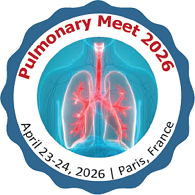Call for Abstract
Scientific Program
14th Annual Congress on Pulmonary and Critical Care, will be organized around the theme “Transforming Respiratory Health: Breakthroughs in Diagnosis, Treatment & Critical Care”
Pulmonary Meet 2026 is comprised of keynote and speakers sessions on latest cutting edge research designed to offer comprehensive global discussions that address current issues in Pulmonary Meet 2026
Submit your abstract to any of the mentioned tracks.
Register now for the conference by choosing an appropriate package suitable to you.
This track covers a broad spectrum of respiratory issues, including infections, asthma, COPD, ILD, pulmonary hypertension, and structural lung disorders. Emphasis for 2026 is on integrated diagnostics, precision therapy, digital lung-health monitoring, and holistic care approaches that address both acute and chronic conditions.
Sleep-related respiratory disorders include obstructive and central sleep apnea, complex sleep apnea, sleep-related hypoventilation, and movement-related sleep disturbances. Treatments range from CPAP, BiPAP, and ASV devices to lifestyle modification, oral appliances, and surgical interventions. Early diagnosis is key to preventing cardiovascular and metabolic consequences.
Pulmonary hypertension is elevated blood pressure in the pulmonary arteries, leading to strain on the heart and impaired oxygenation. In 2026, research focuses on novel vasodilators, targeted therapies for PAH, improved imaging, and early detection strategies. Associated conditions include autoimmune disorders, congenital heart disease, and pulmonary embolism.
Asthma involves chronic airway inflammation leading to wheezing, breathlessness, chest tightness, and coughing. Modern asthma care integrates biologic therapies, personalized inhaler regimens, environmental control, and digital monitoring tools for optimal disease control and patient empowerment.
Effective prevention strategies include vaccination (influenza, pneumococcal, BCG), smoking cessation programs, environmental protection, occupational safety, and strong infection-control practices. Public health initiatives, early detection, and behavioral changes are crucial for reducing the global respiratory disease burden.
Tuberculosis (TB) continues to pose a global public health challenge. 2026 focuses on rapid diagnostics, shorter treatment regimens, drug-resistance management, and improved vaccines. Understanding the clinical spectrum—from latent TB to active disease—remains essential for early detection and control.
Pleural diseases affect the membranes surrounding the lungs and can cause significant respiratory compromise. Advances in 2026 include minimally invasive diagnostic techniques, thoracoscopy, pleural ultrasound, and biomarker-based differentiation of pleural effusions. Tailored therapies and interdisciplinary care are improving patient outcomes.
Respiratory tract infections (RTIs) range from mild viral illnesses to severe bacterial pneumonia. Enhanced diagnostic tools, rapid molecular testing, antiviral innovations, and lessons from the COVID-19 era continue to improve prevention and management. Global collaborative research drives progress in preparedness and response strategies.
Respiratory disorders include a wide range of acute and chronic conditions affecting lung function. The field is evolving with breakthroughs in molecular diagnostics, digital respiratory monitoring, AI tools, and environmental health-focused research. Multidisciplinary management remains essential for improved patient care and long-term outcomes.
Pulmonology, or respiratory medicine, focuses on diseases of the lungs, airways, and respiratory muscles. Pulmonologists diagnose and treat conditions that impair breathing and lung function. Common disorders include asthma, COPD, lung cancer, pneumonia, and tuberculosis. With growing clinical innovations, pulmonology continues to advance through improved diagnostics, multidisciplinary care, and personalized treatment strategies.
Lung cancer remains a major global health challenge and a leading cause of cancer-related deaths. Research in 2026 emphasizes precision oncology, early detection technologies, biomarker-driven therapies, liquid biopsies, targeted treatments, and advanced immunotherapies. These developments are transforming survival outcomes and enabling highly individualized cancer care.
COPD, encompassing chronic bronchitis and emphysema, is marked by progressive airflow limitation. Advances for 2026 include next-generation inhalers, biologic therapies, endobronchial interventions, enhanced pulmonary rehabilitation, and personalized medicine approaches. Early detection and risk-factor modification remain critical for improving prognosis.
Pulmonary rehabilitation improves physical conditioning, symptom control, and emotional well-being in chronic respiratory disease. Modern programs integrate personalized training, tele-rehabilitation, digital monitoring, and behavior-change strategies, significantly enhancing quality of life and long-term functional capacity.
Lung transplantation offers life-saving treatment for advanced lung diseases such as COPD, pulmonary fibrosis, cystic fibrosis, and severe pulmonary hypertension. Ongoing innovations in surgical methods, organ preservation, donor-recipient matching, and immunosuppression have improved survival and quality of life. Transplant approaches include single-lung, double-lung, and heart-lung procedures.
Cystic fibrosis is a genetic disorder affecting the respiratory and digestive systems due to CFTR gene mutations. Transformative therapies such as CFTR modulators and ongoing gene-therapy research are significantly improving life expectancy. The 2026 track highlights innovations in precision medicine, infection control, and multidisciplinary care.
Chronic bronchitis, a major component of COPD, is defined by long-term airway inflammation and persistent mucus-producing cough. Advances in 2026 emphasize early identification, combination therapies, pulmonary rehabilitation, smoking cessation support, and improved disease-management models.
ILD includes a diverse group of disorders characterized by lung tissue inflammation and fibrosis. Idiopathic Pulmonary Fibrosis, NSIP, DIP, connective-tissue disease–related ILD, occupational ILD, and drug-induced ILD remain central research areas. Advances in antifibrotic therapies, imaging techniques, and multidisciplinary care are improving diagnostic accuracy and management.
Infectious respiratory diseases—including common colds, sinusitis, bronchitis, pneumonia, tuberculosis, influenza, COVID-19, and RSV—remain major global concerns. The 2026 focus includes pathogen surveillance, antimicrobial stewardship, vaccine development, and emerging therapeutic modalities.

